 Image search results - "hinaga" Image search results - "hinaga" |

JR Gotanda Station, east entrance 五反田駅
|
|
|

JR Gotanda Station, east entrance 五反田駅
|
|

JR Gotanda Station as seen from Keihin Kyuko Gotanda Station.
|
|

JR Gotanda Station, east side
|
|

JR Gotanda Station, east side
|
|

JR Gotanda Station, east side
|
|

JR Gotanda Station, east side
|
|

Route 1 in Higashi-Gotanda
|
|

JR Gotanda Station, east side
|
|

JR Gotanda Station and Tokyu, road to Sony HQ
|
|

JR Gotanda Station, west side being completely redeveloped.
|
|

JR Gotanda Station, west side being completely redeveloped in April 2007.
|
|

Route 1 in Nishi-Gotanda toward TOC.
|
|

JR Shinagawa Station, Takanawa Entrance on the west side. 品川駅 高輪口
|
|
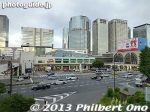
JR Shinagawa Station, Takanawa Entrance on the west side. 品川駅 高輪口
|
|

JR Shinagawa Station, Takanawa Entrance on the west side. 品川駅 高輪口
|
|

High-rise modern hotels have long replaced the old inns at Shinagawa-juku, the Tokaido Road's first post town during the Edo Period.
|
|

Near Shinagawa Station is this poor little shrine called, Takayama Inari Shrine, encroached on all sides by urban development. 高山稲荷神社
|
|

Way to the old Tokaido Road at Shinagawa. It was around here where Godzilla first set foot on Japan, in the first Godzilla movie.
|
|

Entrance to the Tokaido Road at Shinagawa. Short walk from Shinagawa Station.
|
|

Near the entrance to the Tokaido Road is this tourist info booth. Free pamphlets (English included) and maps of Shinagawa-juku.
|
|

Shinagawa-juku along the old Tokaido Road looks like this today. In the old days, it looked like this.
|
|

A convenience store and condominium now at the location of Dozo Sagami, a secret meeting place of Ito Hirobumi and other Imperial loyalists seeking to oust the Tokugawa government during the Bakumatsu period. 土蔵相模跡
|
|

I went on a Sunday when most of the shops were closed. Blessing in disguise because I got to see the ukiyoe art on their shutter doors.
|
|
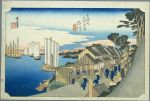
Hiroshige's woodblock print of Shinagawa-juku (2nd post town on the Tokaido) from his "Fifty-Three Stations of the Tokaido Road" series.
|
|
|

The ukiyoe art are all related to Shinagawa.
|
|
|
|
|
|

It is unfortunate that no one thought about preserving this historic stage town on the Tokaido Road. Tokyo may be too urban to have a long road of traditional buildings.
|
|

Shinagawa beer
|
|

Rest stop
|
|

Message in English
|
|

Hinkai Park
|
|
|
|

Shinagawa-juku road marker
|
|

Shinagawa-juku famous spot marker. It reads "Kyu-Tokaido no Nigiwai" meaning "Full of People on the Tokaido."
|
|

Sign explaining about Shinagawa-juku. There were 1,600 buildings and a population of 7,000. The town was right on the waterfront which used to exist before the land reclamation.
|
|

"Kita-Shinagawa Koko Kara"
|
|

Still just modern buildings in Shinagawa-juku, looking like any ordinary street in Japan.
|
|

Isshinji Temple, associated with the god of longevity, Jurojin.
|
|

Isshinji Temple gate sign
|
|

Isshinji Temple is a branch of Narita-san.
|
|

Painting shutter art. Looks like a pine tree.
|
|

More shutter art.
|
|

Site of Shinagawa-juku's Honjin. 品川宿 本陣
|
|

Site of Shinagawa-juku's Honjin. 品川宿 本陣
|
|

Pine tree at Shinagawa-juku's Honjin. The pine tree came from Tsuchiyama-juku in Koka, Shiga Prefecture.
|
|

Sign explaining about the pine tree. Tsuchiyama in Shiga Prefecture was the 49th post town on the Tokaido Road.
|
|

Shinagawa-juku Honjin marker.
|
|

Site of Shinagawa-juku's Honjin. Seems to be used for parking bicycles... 品川宿 本陣
|
|

Road to Shinagawa Shrine.
|
|

Shinagawa Shrine faces Daiichi Keihin, a major highway.
|
|

Shinagawa Shrine 品川神社
|
|

Shinagawa Shrine torii at street level.
|
|

Daikokuten, God of Wealth, Farmers, Agriculture, and Rice. He stands on bales of rice.
|
|

Sightseeing marker
|
|

Torii
|
|

Marker for "New 100 Views of Tokyo."
|
|
|

Second torii
|
|

Third torii
|
|

Honden main hall of Shinagawa Shrine, one of Shinagawa Ward's major shrines. Dedicated to Amenohirinome-no-Mikoto, Susano-o-no-Mikoto, and Uganome-no-Mikoto. Near Shin-Bamba Station North Exit on the Keihin Kyuko Line from Shinagawa Station.
|
|

Honden main hall, Shinagawa Shrine
|
|

Honden main hall, Shinagawa Shrine
|
|
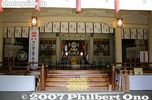
Honden main hall, Shinagawa Shrine
|
|
|
|

Kaguraden for sacred dances.
|
|
|

Kappa
|
|

Cherry blossoms
|
|

Monument says that the practice of visiting all the seven shrines for the Seven Gods of Good Fortune started here.
|
|

Memorial for knives.
|
|

Sight from the shrine's hill. Keihin Kyuko train runs parallel to the old Tokaido Road in Shinagawa.
|
|

Daiichi Keihin highway in front of the shrine and Shin-Bamba Station on the Keihin Kyuko Line.
|
|

Traffic sign for Tokaido Road.
|
|

Shinagawa Bridge, with a small park on the bridge. 品川橋
|
|

Shinagawa Bridge over the Meguro River. After Nihonbashi Bridge in Edo, this was the next major bridge to cross on the Tokaido. 品川橋
|
|

Map of the walking route along Shinagawa-juku.
|
|

Shinagawa Bridge and Meguro River.
|
|

Meguro River as seen from Shinagawa Bridge. The river served as the boundary between Kita-Shinagawa (northern Shinagawa) and Minami-Shinagawa (southern Shinagawa).
|
|

Bridge to Ebara Shrine.
|
|

Bridge to Ebara Shrine with cherry blossoms.
|
|

Ebara Shrine torii and bridge.
|
|

Cherry blossoms along the Meguro-gawa River.
|
|
|

Ebara Shrine. Near Shinagawa bridge and adjacent to cherry-lined Meguro River on the left. 荏原神社
|
|

Ebara Shrine torii
|
|

The shrine is associated with Ebisu, the god of fishermen (notice the fishing pole) and good fortune.
|
|

Ebara Shrine and priest
|
|

Ebara Shrine also holds the Sanno Festival in early June.
|
|

Ebara Shrine is only one of many shrines and temples in this area.
|
|

Looks like a former police box (koban) next to Shinagawa Bridge.
|
|

These frequent signs saying "Tokaido Shinagawa-juku" try to remind you that you're in Shinagawa-juku.
|
|

Unfortunately, there are no post town buildings except for numerous shrines and temples.
|
|

The only other traditional things you see are pine trees. This one came from Hamamatsu in Shizuoka.
|
|
|

Other shukuba (post towns), especially in the rural areas, have been successful in making their buildings look traditional. But Shinagawa was a total failure in this regard.
|
|

If they could even build one traditional-looking building here, more tourists would come. But the most traditional-looking building is this public toilet.
|
|
|

Rest stop (a bench).
|
|

More pine trees. This one came from Oiso in Kanagawa Pref.
|
|

Police box looks traditional.
|
|

Aomono-Yokocho Station on the Keihin Kyuko Line. This must be one of the ugliest train stations in Tokyo. The old Tokaido Road goes further beyond, but I stopped here.
|
|

Daiichi Keihin highway. One road which replaced the Tokaido Road.
|
|

In late Sept., Shinagawa holds the annual Shukuba Festival highlighted by a small parade of people wearing Edo Period costumes (江戸風俗行列).
|
|

The parade is led by these Buddhist monks chanting in front of a local temple.
|
|

Police on white motorcycle.e.
|
|
|
|
|
|
|
|
|
|
|

This is the Honorary Shinagawa Police Chief for the day, voice actress and impersonator Ayano Fukuda (福田彩乃).
|
|

The parade is also part of a traffic safety campaign.
|
|
|

Local school band.
|
|
|
|

"Beware of investment fraud"
|
|

"Beware of dangerous drugs"
|
|

Shinagawa Mothers Association
|
|
|
|
|
|

Local cheerleaders.
|
|
|
|
|
|

Shinagawa Joshi Gakuin
|
|
|
|
|
|

At the head of the costume parade was Mito Komon. On the left in kimono is Andrijana Cvetkovik, Macedonian Ambassador to Japan. She's holding her country's flag. The Macedonian Embassy is in Shinagawa. On the right is someone from Brazil
|
|
|

The liveliest part of the parade. These people were offering candy to spectators like they did in the old days.
|
|
|
|

Before newspapers, they passed out news flyers called kawaraban in the Edo Period for major events and notices. She gave out festival flyers.
|
|

Candy vendors. The people parading in these costumes are all ordinary people who paid ¥15,000 to ¥30,000 for the privilege. To cover the makeup and costume fees.
|
|
|
|
|

Isshin Tasuke (一心太助) fictional Edo Period fishmonger was the ideal Edokko.
|
|
|
|
|
|

Yaoya Oshichi (八百屋お七, ca. 1667–1683), literally "greengrocer Oshichi", was a daughter of the greengrocer Tarobei who lived in the Hongo neighborhood of Edo at the beginning of the Edo period.She was executed for attempting to commit arson. The story became the subject of joruri plays.
|
|

Wearing black and red is Nezumi Kozō (鼠小僧) (1797–1831), a Japanese thief and folk hero who lived in Edo during the Edo period.
|
|
|
|
|

The problem with this parade is that they don't identify who's who. I have a list of Edo Period characters in the parade and I can identify the major ones, but not this one with the bare shoulder.
|
|
|
|
|
|
|
|
|
|
|
|
|
|
|
|
|
|
|

Students from a kimono school.
|
|

Students from a kimono school.
|
|
|

This is a komuso, a Zen monk who went around playing the shakuhachi bamboo flute while wearing a basket on the head. This is how they meditated and begged. Ninja famously disguised themselves as komuso.
|
|
|
|

Modern Dance Company, Seagull
|
|
|
|
|
|
|
|
|

Gama no abura or Toad's Oil
|
|

Small park had food booths.
|
|

Folk performances at a small park.
|
|

Flea market
|
|
|
|
|

PR for the latest Godzilla movie. There were Godzilla movie posters and flyers all over the place. I had to ask why. Found out that in the first Godzilla movie in the 1950s, Shinagawa was where Godzilla first set foot on Japan (near Shinagawa Station).
|
|
|

Kita-Shinagawa Station on the Keihin Kyuko (Keikyu) Line.
|
|

Shinagawa Station on the Keihin Kyuko (Keikyu) Line.
|
|

Shinagawa Station on the Keihin Kyuko (Keikyu) Line.
|
|

Shinagawa Station on the Keihin Kyuko (Keikyu) Line.
|
|

Shinagawa Station on the Keihin Kyuko (Keikyu) Line.
|
|

Now in Shinagawa, at the U-turn.
|
|

Shinagawa U-turn (15 km point)
|
|
|

Cameras were also at the Shinagawa U-turn where some runners posed.
|
|
|

From Shinagawa, they head to Ginza.
|
|

Banner
|
|
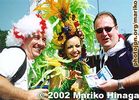
Shizuoka Ecopa Satdium on June 21, 2002. England vs. Brazil. Photos by Mariko Hinaga.
|
|
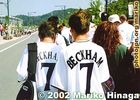
Megastar David Beckham was with England.
|
|
|
|
|
|
|
|
|
|
|
|
|
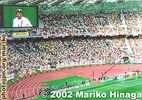
Shizuoka Ecopa Stadium, Beckham on the screen.
|
|

This is Shinagawa-juku in Tokyo, the site of the Honjin. On the left is a pine tree from Tsuchiyama.
|
|

Pine tree from Tsuchiyama at the site of Shinagawa-juku's Honjin in Tokyo.
|
|
|
|
|
|